Tribological and Morphological Study of AISI 316L Stainless Steel during Turning under Different Lubrication Conditions
Abstract
1. Introduction
2. Methodology
3. Results and Discussions
3.1. Surface Roughness
3.2. Cutting Force
3.3. Tool Wear
4. Conclusions
- The surface roughness value was found to be minimal under neem oil application compared to other lubricants because of the optimum viscosity, penetrability and high flash point of the neem oil. From the examination of the percentage of contribution (P%) for the selected range of input parameters, it can be seen that lubrication conditions have the highest contribution of about 98.1% compared to cutting speed (P = 1.74%), feed (P = 0.03%) and depth of cut (P = 0.04%). Further, the selection of neem oil as lubricant with cutting speed (140 m/min), feed (0.30 mm/rev) and depth of cut (1.0 mm) has resulted in the best combination among the selected range of input parameters to obtain the lowest surface roughness value of 0.36µm.
- A similar observation was found for cutting force. As neem oil flows easily, it reduces frictional forces by deeply penetrating into the capillaries existing between the tool–chip interfaces. From the examination of the percentage of contribution (P%) for the selected range of input process parameters, lubrication condition had the highest contribution of 91.9% compared to cutting speed (P = 4.25%), feed (P = 2.86%) and depth of cut (P = 0.99%). Further, the selection of neem oil as lubricant with cutting speed (140 m/min), feed (0.20 mm/rev) and depth of cut (1.0 mm) resulted in the best combination to get the lowest cutting force value (235.34 N).
- Tool wear was lesser under neem oil application because neem oil penetrates easily on to chip–tool interface and creates a fine film resulting in minimum friction and tool wear compared to other cutting fluids. From the evaluation of the contribution percentage (P%), it can be seen that lubrication conditions have the highest contribution of about 84.1%, while cutting speed (P = 7.46%), feed (P = 3.46%) and depth of cut (P = 4.98%) have a minimal statistical and physical significance on tool wear for the selected range of input parameters. Further, the selection of neem oil as lubricant with cutting speed (60 m/min), feed (0.10 mm/rev) and depth of cut (0.2 mm) resulted in the best combination to get the lowest tool wear value (100.32 microns).
Author Contributions
Funding
Data Availability Statement
Acknowledgments
Conflicts of Interest
Nomenclature and Abbreviations:
| AISI | American Iron and Steel Institute |
| MQL | Minimum Quantity Lubrication |
| ANOVA | Analysis of Variance |
| S/N Ratio | Signal to Noise Ratio |
| Fz | Cutting Force |
| Vb | Tool Wear |
| Ra | Roughness Average |
| OW | Oil–Water |
| MO | Mineral Oil |
| PO | Pongam Oil |
| SO | Simarouba Oil |
| NO | Neem Oil |
| DF | Degrees of Freedom |
References
- Tesler, A.B.; Kim, P.; Kolle, S.; Howell, C.; Ahanotu, O.; Aizenberg, J. Extremely durable biofouling-resistant metallic surfaces based on electrodeposited nanoporoustungstite films on steel. Nat. Commun. 2015, 6, 1–10. [Google Scholar] [CrossRef] [PubMed]
- Bharsai, N.S.; Kannan, S. Microstructure, Corossion and mechanical properties characterization of AISI type 316L(N) stainless steel and modified 9Cr-1Mo steel after 40,000 h of dynamic sodium exposure at 525 °C. J. Nucl. Mater. 2019, 516, 84–89. [Google Scholar] [CrossRef]
- Suleiman, I.Y.; Sani, A.M.; Ogheneblorhie, C. Characterisation and corrosion behaviours of AISI 316 in hydrochloric environment at various concentrations. Zast. Materrijala 2020, 61, 220–228. [Google Scholar]
- Mia, M.; Dhar, N.R. Effects of duplex jets high pressure coolant on machining temperature and machinability of Ti-6Al-4V superalloy. J. Mater. Process. Technol. 2018, 252, 688–696. [Google Scholar] [CrossRef]
- Masoudi, S.; Esfahani, M.J.; Jafarian, F.; Mirsoleimani, S.A. Comparison the effect of MQL, wet and dry turning on surface topography, cylindricity tolerance and sustainability. Int. J. Precis. Eng. Manuf. Green Technol. 2019. [Google Scholar] [CrossRef]
- Shokrani, A.; Dhokia, V.; Newman, S.T. Environmentally conscious machining of difficult-to-machine materials with regard to cutting fluids. Int. J. Mach. Tools Manuf. 2012, 57, 83–101. [Google Scholar] [CrossRef]
- Weinert, K.; Inasaki, I.; Sutherland, J.; Wakabayashi, T. Dry machining and minimum quantity lubrication. CIRP Ann. Manuf. Technol. 2004, 53, 511–537. [Google Scholar] [CrossRef]
- Inasaki, I. Towards symbiotic machining processes. Int. J. Precis. Eng. Manuf. 2012, 13, 1053–1057. [Google Scholar] [CrossRef]
- Goldberg, M. Improving productivity by using innovative metal cutting solutions with an emphasis on green machining. Int. J. Mach. Mach. Mater. 2012, 12, 17–125. [Google Scholar] [CrossRef]
- Tawakoli, T.; Hadad, M.; Sadeghi, M.; Daneshi, A.; Stöckert, S.; Rasifard, A. An experimental investigation of the effects of workpiece and grinding parameters on minimum quantity lubrication-MQL grinding. Int. J. Mach. Tools Manuf. 2009, 49, 924–932. [Google Scholar] [CrossRef]
- Jegatheesan, V.; Liow, J.L.; Shu, L.; Visvanathan, C. The need for global coordination in sustainable development. J. Clean. Prod. 2009, 17, 637–643. [Google Scholar] [CrossRef]
- Hadad, M.J.; Sadeghi, B. Thermal analysis of minimum quantity lubrication- MQL grinding process. Int. J. Mach. Tools Manuf. 2012, 63, 1–15. [Google Scholar] [CrossRef]
- Sadeghi, M.H.; Haddad, M.J.; Tawakoli, T.; Emami, M. Minimal quantity lubrication-MQL in grinding of Ti-6Al-4V titanium alloy. Int. J. Adv. Manuf. Technol. 2009, 44, 487–500. [Google Scholar] [CrossRef]
- Li, K.M. Predictive Modeling of Near Dry Machining: Mechanical Performance and Environmental Impact. Ph.D. Thesis, Georgia Institute of Technology, Atlanta, GA, USA, 2006. [Google Scholar]
- Sharma, V.S.; Dogra, M.; Suri, N.M. Cooling techniques for improved productivity in turning. Int. J. Mach. Tools Manuf. 2009, 49, 435–453. [Google Scholar] [CrossRef]
- Attanasio, A.; Gelfi, M.; Giardini, C.; Remino, C. Minimal quantity lubrication in turning: Effect on tool wear. Wear 2006, 260, 333–338. [Google Scholar] [CrossRef]
- Obikawa, T.; Kamata, Y.; Asano, Y.; Nakayama, K.; Otieno, A.W. Micro-liter lubrication machining of Inconel 718. Int. J. Mach. Tools Manuf. 2008, 48, 1605–1612. [Google Scholar] [CrossRef]
- Karthik, S.R.; Londe, N.; Shetty, R.; Nayak, R.; Hegde, A. Optimization and prediction of hardness, wear and surface roughness on age hardened Stellite 6 alloys. Manuf. Rev. 2022, 9, 10. [Google Scholar]
- Shetty, R.; Sanjeev Kumar, C.R.; Ravindra, M.R. RSM based expert system development for cutting force prediction during machining of Ti-6Al-4V under minimum quantity lubrication. Int. J. Syst. Assur. Manag. 2021, in press. [CrossRef]
- Shetty, R. L16 Orthogonal Array Based Three Dimensional Finite Element Modelling for Cutting force and chip formation analysis during Dry Machining of Ti-6Al-4V. J. Adv. Manuf. Syst. World Sci. 2021, 20, 123–134. [Google Scholar] [CrossRef]
- Kamata, Y.; Obikawa, T. High speed MQL finishturning of Inconel 718 with different coated tools. J. Mater. Process. Technol. 2007, 192–193, 281–286. [Google Scholar] [CrossRef]
- Mannekotte, J.; Kailas, S.V.; Kathyayini, N. Environmentally Friendly Functional Fluids from Renewable and Sustainable sources. J. Renew. Sustain. Energy 2017, 81, 1787–1801. [Google Scholar] [CrossRef]
- Shashidhara, Y.M.; Jayaram, S.R. Vegetable oils as potential cutting fluids an evolution. Tribol. Int. 2010, 43, 1073–1081. [Google Scholar] [CrossRef]
- Rahim, E.A.; Sasahara, H. A study of the effect of palm oil as MQL Lubricant of high-speed titanium alloys. J. Tribol. Int. 2011, 44, 309–317. [Google Scholar] [CrossRef]
- Ozcelik, B.; Kuram, E.; Cetin, M.H.; Demirbas, E. Experimental investigations of vegetable based cutting fluids with extreme pressure during turning of Aisi 304l. Tribol. Int. 2011, 44, 1864–1871. [Google Scholar] [CrossRef]
- Abdalla, H.S.; Baines, W.; McIntyre, G.; Slade, C. Development of novel sustainable neat-oil metal working fluids for stainless steel and titanium Alloy machining. Part 1. Formulation development. Int. J. Adv. Manuf. Technol. 2007, 34, 21. [Google Scholar] [CrossRef]
- Nagendramma, P.; Kaul, S. Development of eco-friendly/biodegradable lubricants: An overview. Renew. Sustain. Energy Rev. 2012, 16, 764–774. [Google Scholar] [CrossRef]
- Leppert, T.; Peng, R.L. Residual stresses in surface layer after dry and MQL turning of AISI 316L steel. Prod. Eng. 2012, 6, 367–374. [Google Scholar] [CrossRef]
- Maruda, R.W.; Krolczyk, G.M.; Niesłony, P.; Krolczyk, J.B.; Legutko, S. Chip formation zone analysis during the turning of austenitic stainless steel 316L under MQCL cooling condition. Proc. Eng. 2016, 149, 297–304. [Google Scholar] [CrossRef]
- Hossain, S.; Abedin, M.Z. Effect of Minimum Quantity Lubrication System for Improving Surface Roughness in Turning Operation. Int. J. Eng. Mater. Manuf. 2021, 6, 50–59. [Google Scholar] [CrossRef]
- Ibrahim, A.M.M.; Omer, M.A.E.; Das, S.R.; Li, W.; Alsoufi, M.S.; Elsheikh, A. Evaluating the effect of minimum quantity lubrication during hard turning of AISI D3 steel using vegetable oil enriched with nano-additives. Alex. Eng. J. 2022, 61, 10925–10938. [Google Scholar] [CrossRef]
- Javid, H.; Jahanzaib, M.; Jawad, M.; Asad Ali, M.; Umar Farooq, M.; Pruncu, C.I.; Hussain, S. Parametric analysis of turning HSLA steel under minimum quantity lubrication (MQL) and nanofluids-based minimum quantity lubrication (NF-MQL): A concept of one-step sustainable machining. Int. J. Adv. Manuf. Technol. 2021, 117, 1915–1934. [Google Scholar] [CrossRef]
- NareshBabu, M.; Anandan, V. Turning SKD 11 Steel Using Silver Nanofluids With Minimum Quantity Lubrication. Int. J. Manuf. Mater. Mech. Eng. 2021, 11, 74–95. [Google Scholar]
- Arsene, B.; Gheorghe, C.; Sarbu, F.A.; Barbu, M.; Cioca, L.-I.; Calefariu, G. MQL-Assisted Hard Turning of AISI D2 Steel with Corn Oil: Analysis of Surface Roughness, Tool Wear, and Manufacturing Costs. Metals 2021, 11, 2058. [Google Scholar] [CrossRef]
- Shetty, R.; Pai, R.B.; Rao, S.S.; Nayak, R. Taguchi’s technique in machining of metal matrix composites. J. Braz. Soc. Mech. Sci. Eng. 2009, 31, 12–20. [Google Scholar] [CrossRef]
- Jayashree, P.K.; Sharma, S.S.; Shetty, R.; Mahato, A.; Gowrishankar, M.C. Optimization of TIG welding parameters for 6061Al alloy using Taguchi’s design of experiments. Mater. Today: Proc. 2018, 5, 23648–23655. [Google Scholar] [CrossRef]
- Shetty, R.; Gurupur, P.R.; Hindi, J.; Hegde, A.; Naik, N.; Ali, M.S.S.; Patil, I.S.; Nayak, M. Processing, Mechanical Characterization and Electric discharge machining of Stir cast and Spray forming based Al-Si alloy reinforced with ZrO2 particulate composites. J. Compos. Sci. 2022, 6, 323. [Google Scholar] [CrossRef]
- Shetty, R.; Hegde, A. Taguchi based fuzzy logic model for optimization and prediction of surface roughness during AWJM of DRCUFP composites. Manuf. Rev. 2022, 9, 2. [Google Scholar]


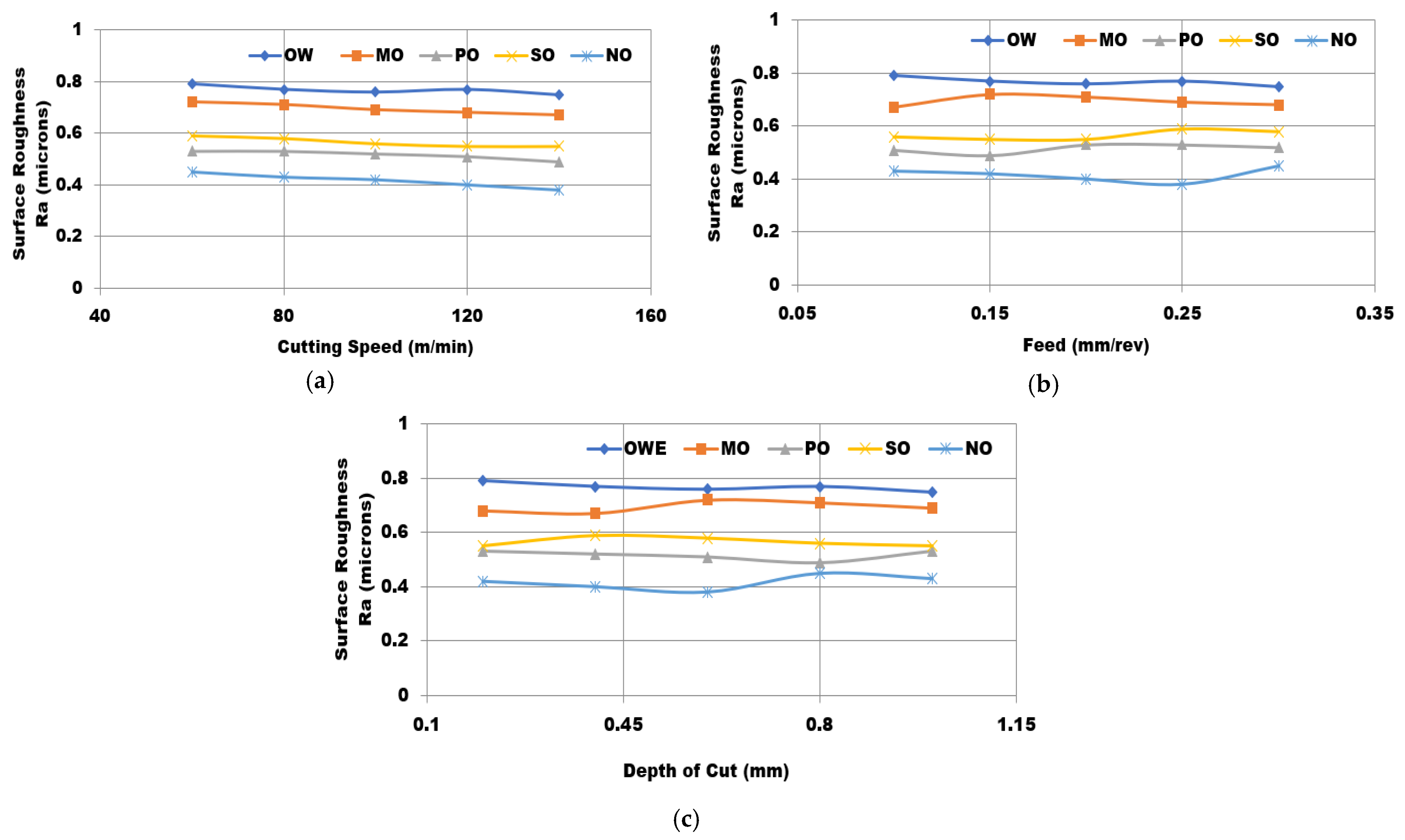


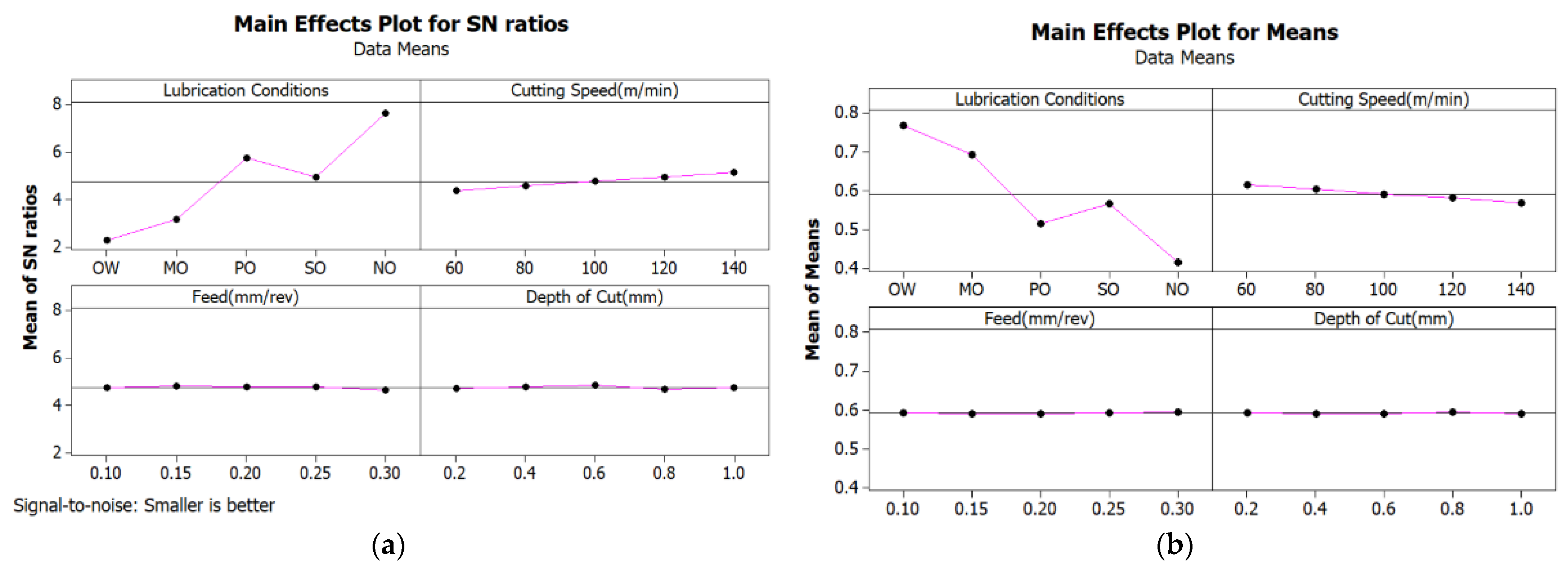
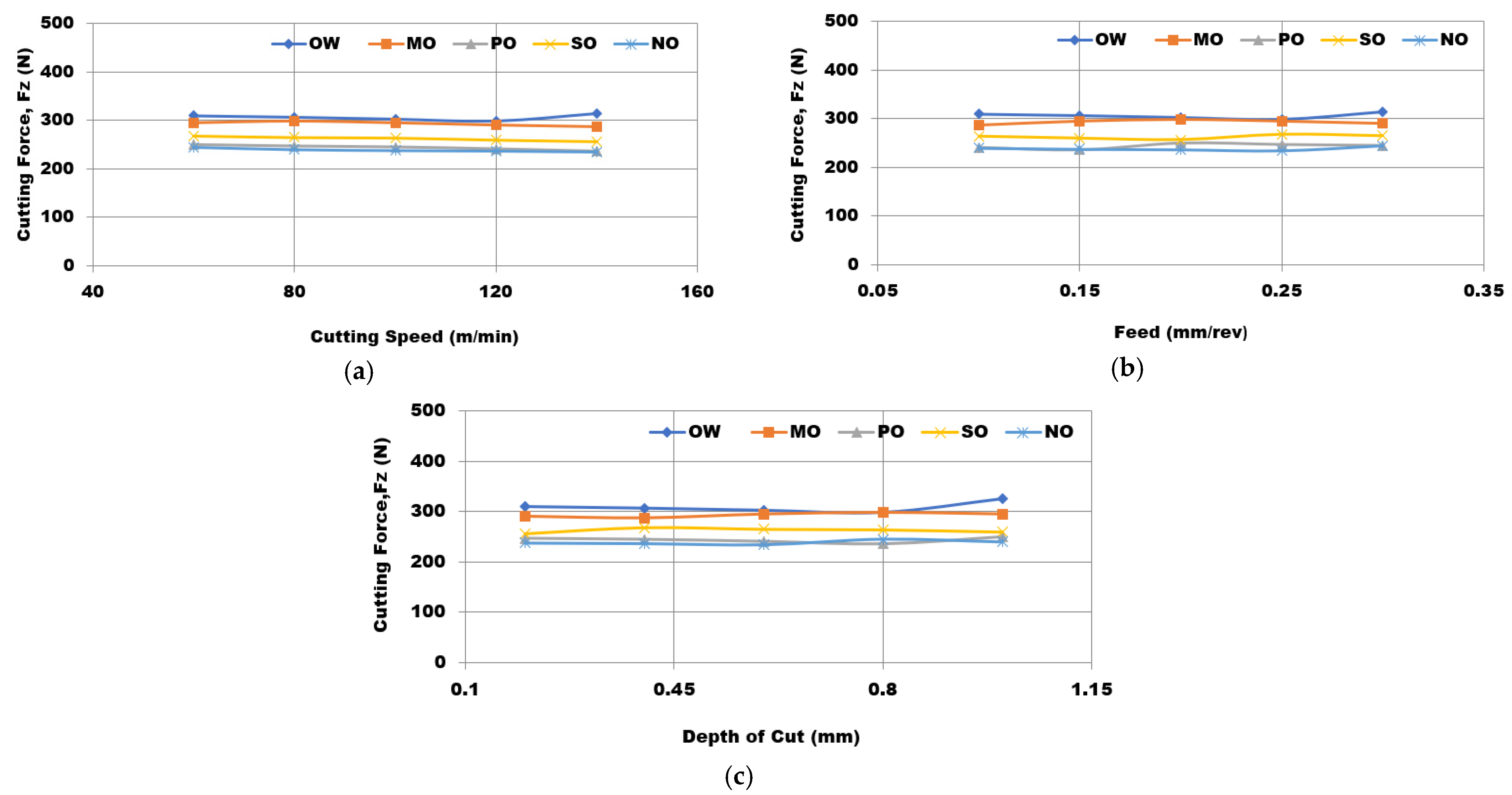
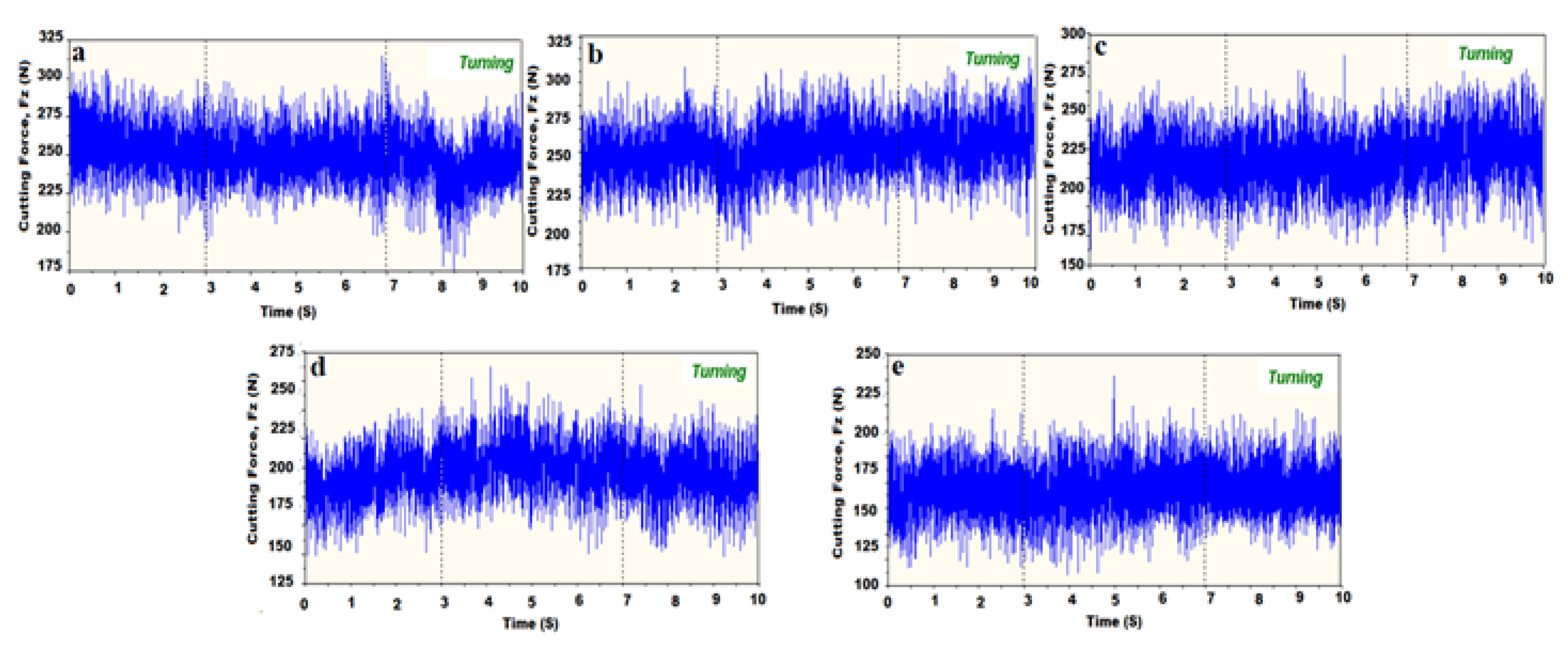
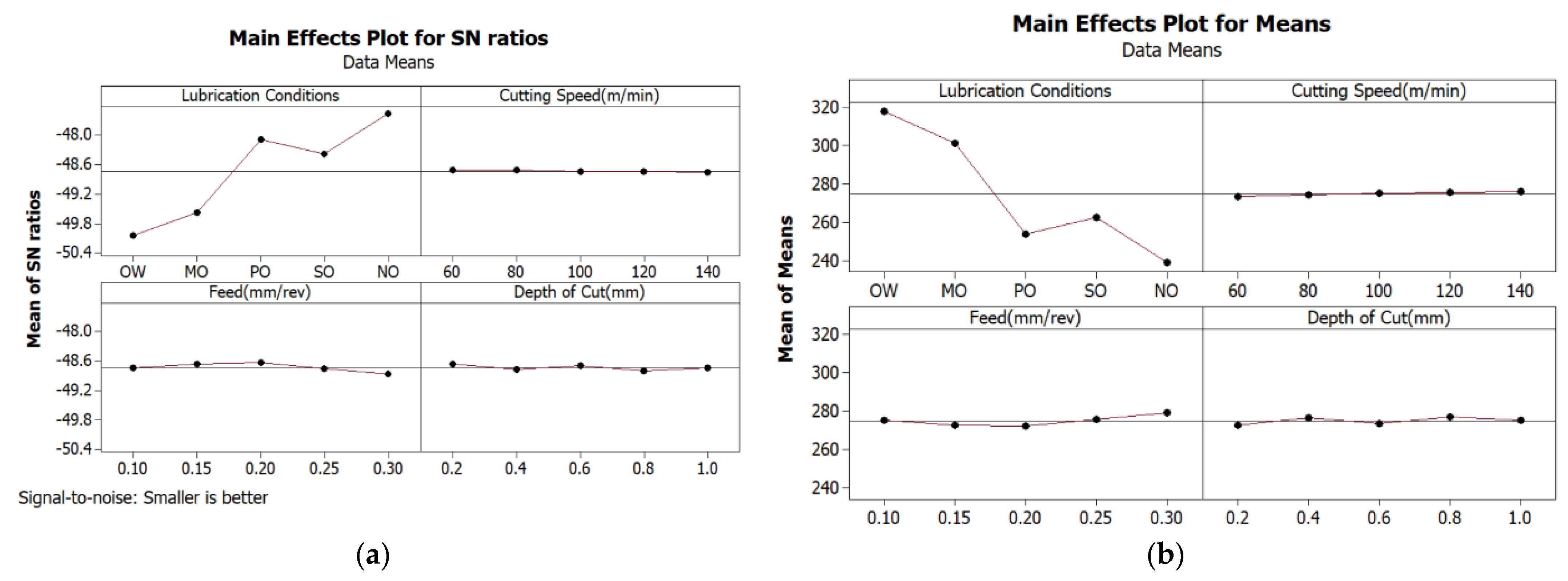
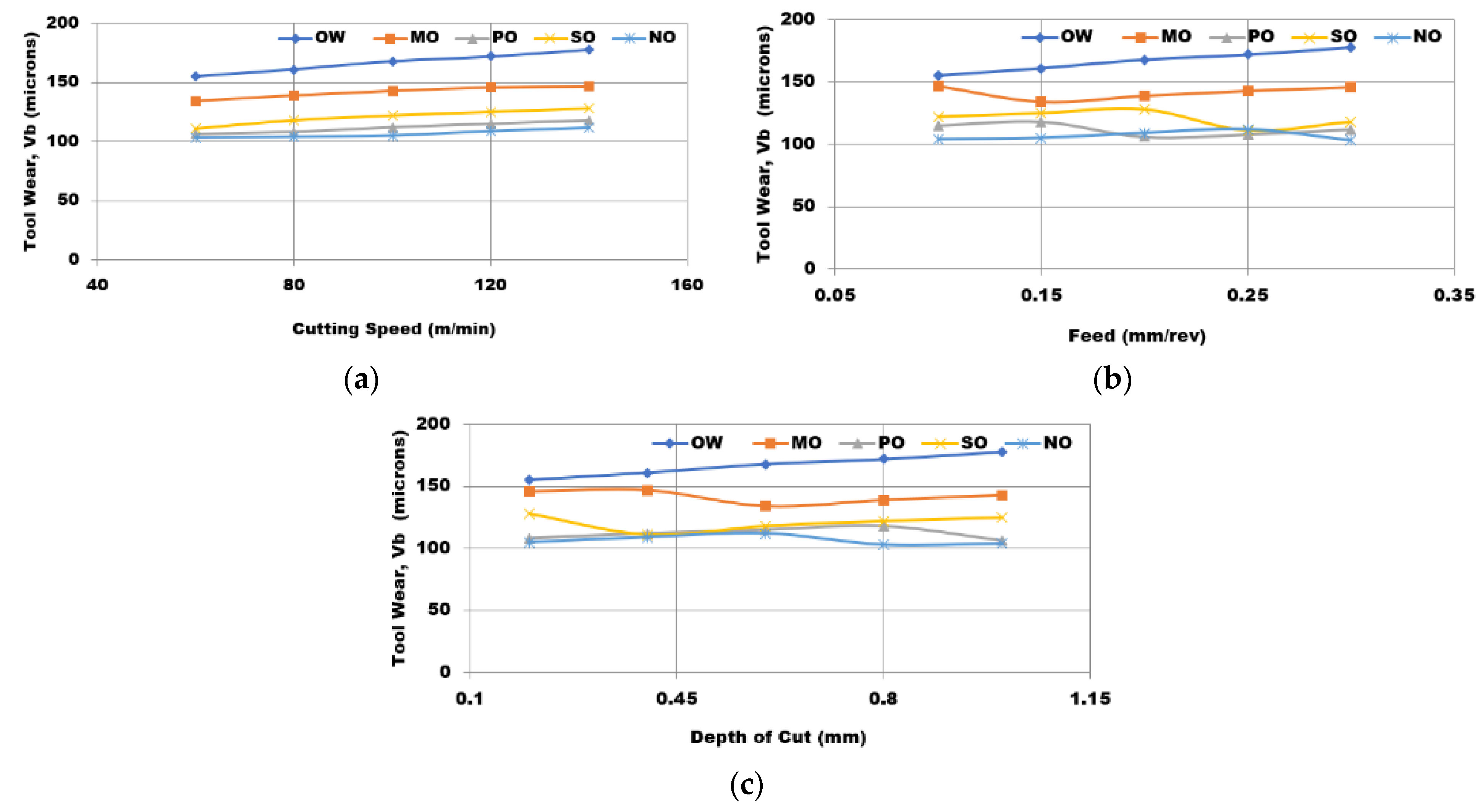
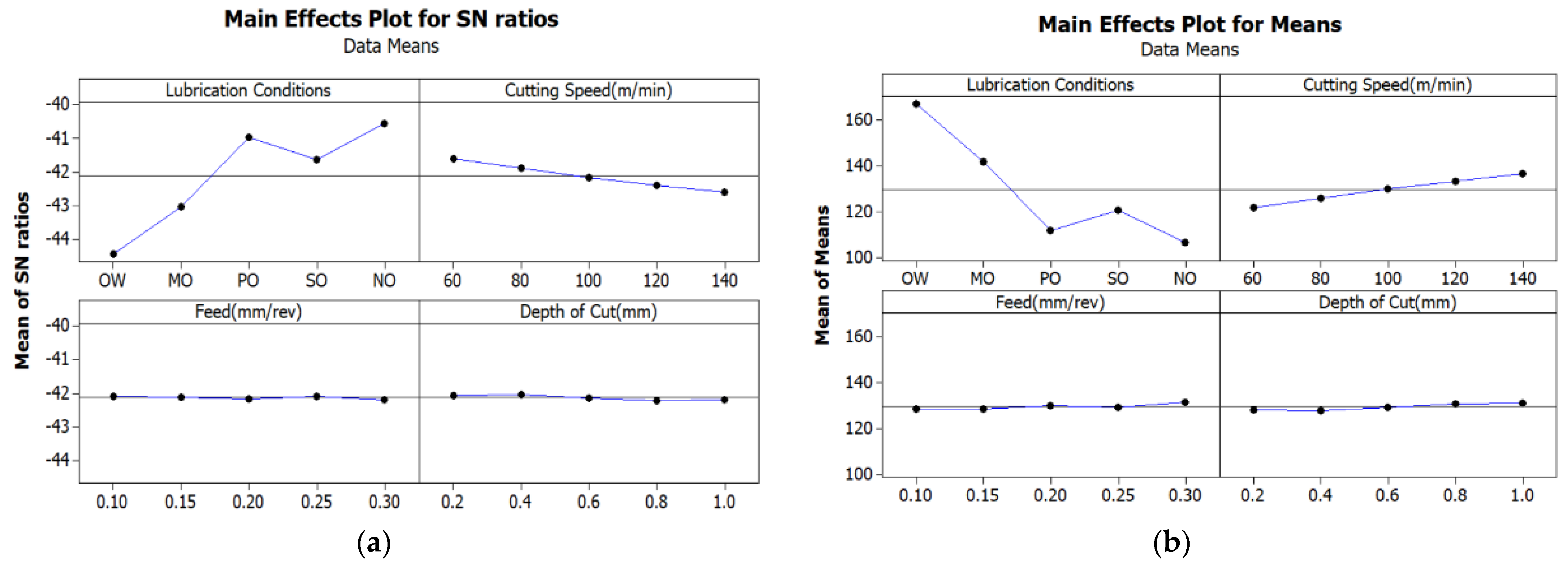
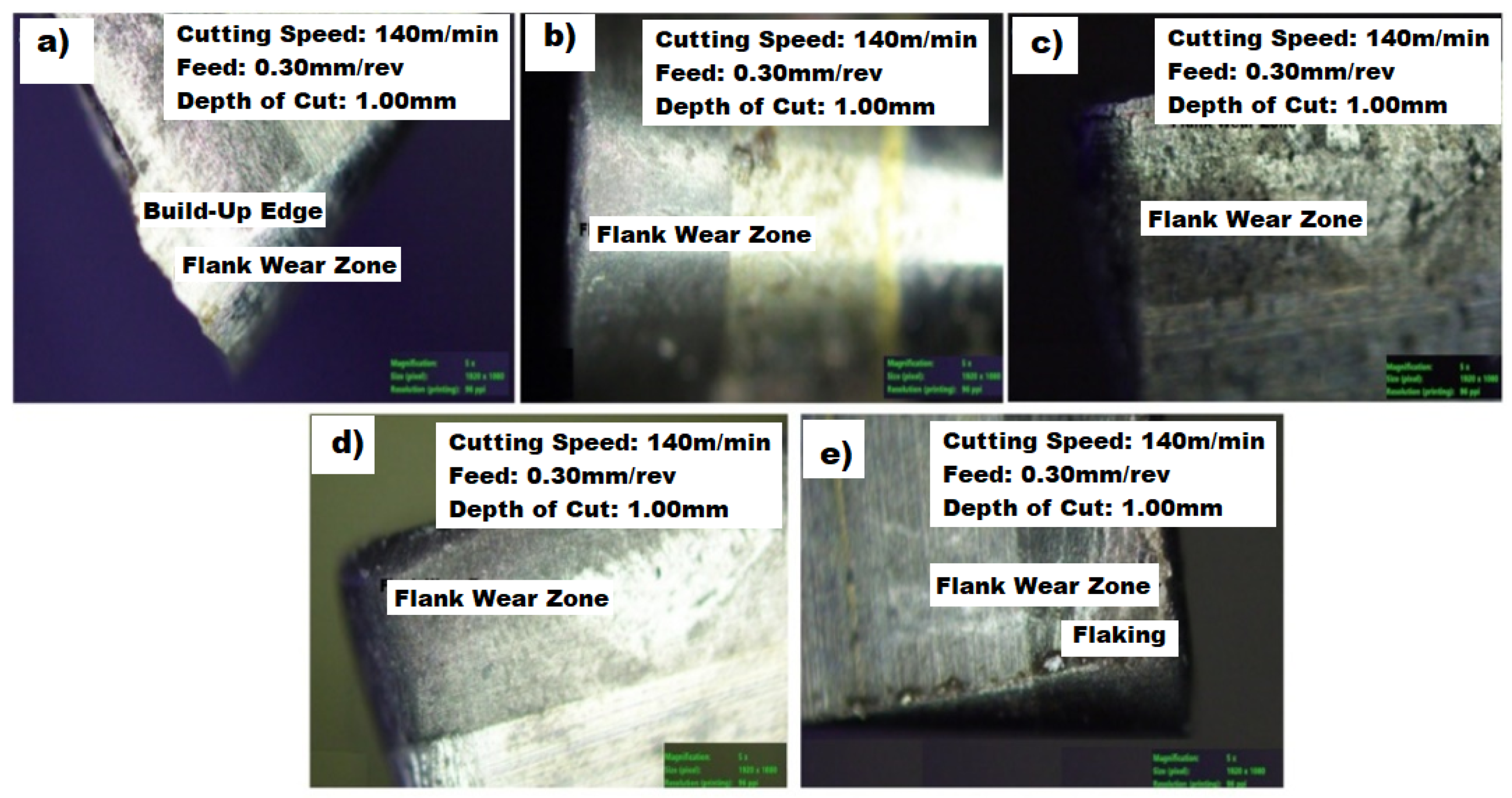
| Properties | Neem Oil (NO) | Simarouba Oil (SO) | Pongam Oil (PO) | Oil–Water (OW) | Mineral Oil (MO) |
|---|---|---|---|---|---|
| Viscosity (≅40 °C) Pa s (Pascal second) | 0.0245–0.028 | 0.0274–0.03107 | 0.0369–0.0415 | 0.027–0.0324 | 0.0826–0.087 |
| % of Oxygen | 0.2–0.5% | 1.2–1.5% | 0.5–0.8% | 20.5–21% | 1.5–2% |
| Density (g/cm3) | 0.875 | 0.914 | 0.924 | 0.900 | 0.870 |
| Flash point | 218 °C | 178 °C | 225 °C | NA | 135 °C |
| Property | Typical Value |
|---|---|
| Hardness, Rockwell B | 95 |
| Ultimate Tensile Strength (MPa) | 485 |
| Yield Tensile Strength (MPa) | 170 |
| Modulus of Elasticity (GPa) | 200 |
| Poisson’s Ratio | 0.3 |
| Density(g/cm3) | 7.90 |
| Elongation (%) | 40 |
| Fatigue Strength (MPa) | 146 |
| Element | C | Mn | Si | P | S | Cr | Mo | Ni | N |
|---|---|---|---|---|---|---|---|---|---|
| Wt (%) | 0.03 | 2 | 0.75 | 0.05 | 0.03 | 18 | 3 | 14 | 0.10 |
| Trial No | Lubrication Conditions (A) | Cutting Speed (m/min) (B) | Feed (mm/rev) (C) | Depth of Cut (mm) (D) |
|---|---|---|---|---|
| 1 | Oil–Water | 60 | 0.10 | 0.20 |
| 2 | Mineral Oil | 80 | 0.15 | 0.40 |
| 3 | Pongam Oil | 100 | 0.20 | 0.60 |
| 4 | Simarouba Oil | 120 | 0.25 | 0.80 |
| 5 | Neem Oil | 140 | 0.30 | 1.00 |
| Trial No | Lubrication Conditions (A) | Cutting Speed (m/min) (B) | Feed (mm/rev) (C) | Depth of Cut (mm) (D) |
|---|---|---|---|---|
| 1 | Oil–Water | 60 | 0.10 | 0.2 |
| 2 | Oil–Water | 80 | 0.15 | 0.4 |
| 3 | Oil–Water | 100 | 0.20 | 0.6 |
| 4 | Oil–Water | 120 | 0.25 | 0.8 |
| 5 | Oil–Water | 140 | 0.30 | 1.0 |
| 6 | Mineral Oil | 60 | 0.15 | 0.6 |
| 7 | Mineral Oil | 80 | 0.20 | 0.8 |
| 8 | Mineral Oil | 100 | 0.25 | 1.0 |
| 9 | Mineral Oil | 120 | 0.30 | 0.2 |
| 10 | Mineral Oil | 140 | 0.10 | 0.4 |
| 11 | Pongam Oil | 60 | 0.20 | 1.0 |
| 12 | Pongam Oil | 80 | 0.25 | 0.2 |
| 13 | Pongam Oil | 100 | 0.30 | 0.4 |
| 14 | Pongam Oil | 120 | 0.10 | 0.6 |
| 15 | Pongam Oil | 140 | 0.15 | 0.8 |
| 16 | Simarouba Oil | 60 | 0.25 | 0.4 |
| 17 | Simarouba Oil | 80 | 0.30 | 0.6 |
| 18 | Simarouba Oil | 100 | 0.10 | 0.8 |
| 19 | Simarouba Oil | 120 | 0.15 | 1.0 |
| 20 | Simarouba Oil | 140 | 0.20 | 0.2 |
| 21 | Neem Oil | 60 | 0.30 | 0.8 |
| 22 | Neem Oil | 80 | 0.10 | 1.0 |
| 23 | Neem Oil | 100 | 0.15 | 0.2 |
| 24 | Neem Oil | 120 | 0.20 | 0.4 |
| 25 | Neem Oil | 140 | 0.25 | 0.6 |
| Source | DF | P | P (%) |
|---|---|---|---|
| Lubrication Conditions (A) | 4 | 0.9810 | 98.1 |
| Cutting Speed (m/min) (B) | 4 | 0.0174 | 1.74 |
| Feed(mm/rev) (C) | 4 | 0.0030 | 0.03 |
| Depth of Cut(mm) (D) | 4 | 0.0040 | 0.04 |
| Residual Error | 8 | ||
| Total | 24 |
| Source | DF | P | P(%) |
|---|---|---|---|
| Lubrication Conditions | 4 | 0.919 | 91.9 |
| Cutting Speed (m/min) | 4 | 0.0425 | 4.25 |
| Feed(mm/rev) | 4 | 0.0286 | 2.86 |
| Depth of Cut(mm) | 4 | 0.0099 | 0.99 |
| Residual Error | 8 | ||
| Total | 24 |
| Source | DF | P | P (%) |
|---|---|---|---|
| Lubrication Conditions | 4 | 0.8410 | 84.1 |
| Cutting Speed (m/min) | 4 | 0.0746 | 7.46 |
| Feed (mm/rev) | 4 | 0.0346 | 3.46 |
| Depth of Cut (mm) | 4 | 0.0498 | 4.98 |
| Residual Error | 8 | ||
| Total | 24 |
Disclaimer/Publisher’s Note: The statements, opinions and data contained in all publications are solely those of the individual author(s) and contributor(s) and not of MDPI and/or the editor(s). MDPI and/or the editor(s) disclaim responsibility for any injury to people or property resulting from any ideas, methods, instructions or products referred to in the content. |
© 2023 by the authors. Licensee MDPI, Basel, Switzerland. This article is an open access article distributed under the terms and conditions of the Creative Commons Attribution (CC BY) license (https://creativecommons.org/licenses/by/4.0/).
Share and Cite
Natesh, C.P.; Shashidhara, Y.M.; Amarendra, H.J.; Shetty, R.; Harisha, S.R.; Shenoy, P.V.; Nayak, M.; Hegde, A.; Shetty, D.; Umesh, U. Tribological and Morphological Study of AISI 316L Stainless Steel during Turning under Different Lubrication Conditions. Lubricants 2023, 11, 52. https://doi.org/10.3390/lubricants11020052
Natesh CP, Shashidhara YM, Amarendra HJ, Shetty R, Harisha SR, Shenoy PV, Nayak M, Hegde A, Shetty D, Umesh U. Tribological and Morphological Study of AISI 316L Stainless Steel during Turning under Different Lubrication Conditions. Lubricants. 2023; 11(2):52. https://doi.org/10.3390/lubricants11020052
Chicago/Turabian StyleNatesh, C. P., Y. M. Shashidhara, H. J. Amarendra, Raviraj Shetty, S. R. Harisha, P. Vishal Shenoy, Madhukara Nayak, Adithya Hegde, Dikshith Shetty, and Utsav Umesh. 2023. "Tribological and Morphological Study of AISI 316L Stainless Steel during Turning under Different Lubrication Conditions" Lubricants 11, no. 2: 52. https://doi.org/10.3390/lubricants11020052
APA StyleNatesh, C. P., Shashidhara, Y. M., Amarendra, H. J., Shetty, R., Harisha, S. R., Shenoy, P. V., Nayak, M., Hegde, A., Shetty, D., & Umesh, U. (2023). Tribological and Morphological Study of AISI 316L Stainless Steel during Turning under Different Lubrication Conditions. Lubricants, 11(2), 52. https://doi.org/10.3390/lubricants11020052





